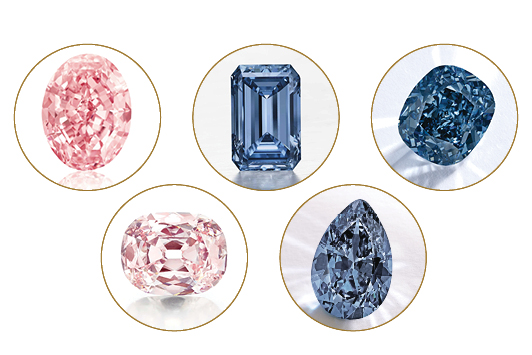
With a return that outstrips white diamonds, rare top-quality examples of colored diamonds are proving to be an attractive alternative investment for buyers with an eye on the future — and pockets deep enough to compete.
Research released last month by the Knight Frank Luxury Investment Index (KFLII) claims the price of colored diamonds has risen 89% in the past decade, while white-diamond appreciation over the same period has been slower at about 30%. The decade’s worth of data that Knight Frank has compiled shows that color matters when it comes to a return on investment. Between 2010 and 2015, pink diamonds delivered the highest growth at 189%, blue diamond prices rose 89%, and yellows were up 17%. Over the past year, however, blue diamonds have taken over as the stone to invest in, delivering a 5.5% increase; average prices of pink diamonds have actually dipped over the past 12 months.
Look a little more closely at the KFLII data and you can spot a slowing in the colored-diamond boom. Average prices of all colored diamonds increased just 15% in the past five years and were flat in the past 12 months. Thomas Gelb of the Natural Color Diamond Association isn’t worried, though.
“Natural color diamonds are in very limited supply, and this will only get worse, as many mines that produce fancy color diamonds will be closing,” he says. “Scarcity is a vital factor when thinking about natural color diamonds.”
Scarcity, of course, pushes up prices, and while that’s good news for those already invested in colored diamonds, could it be prohibitive to those looking to jump on this investment opportunity? At Scarselli Diamonds, at least, demand for fancy colors remains strong.
“We have kept and maintained our inventory of yellow diamonds, as well as invested in more popular sizes in pink and blue diamonds to balance market demands,” says Bruno Scarselli, a partner in the company. “We still maintain that there is exceptional value in the family of yellows, which we increasingly sell well over other colors due to their [comparative] affordability.”
Another potential threat to prices of colored diamonds is the lab-grown diamond. While white lab-grown stones are increasing in popularity, the real potential many see in this area is for color, as the technology places pinks, blues and yellows within the financial grasp of the mid-market for the first time. As such, some traditional diamond dealers, including Bass Premier, have started selling synthetic colored diamonds alongside mined stones.
Gelb, however, remains unperturbed: “They have had no impact on the natural colored-diamond market. I see no reason for this to change. As with all other synthetic gemstones, they are a different product and generally have no effect on the market, as they are not real substitutes and have no intrinsic value. In some ways, they are similar to treated color diamonds; their value is the cost of their production. As these costs drop with economies of scale, the prices of synthetics will drop significantly.”
Though the escalation in prices of mined colored diamonds might have cooled for now, global demand for these rare gems remains robust, according to The Fancy Color Research Foundation, and sales continue to be made. From the look of it, consumers still trust in color.
Images: Christie's; Sotheby's Article from the Rapaport Magazine - October 2017. To subscribe click here.